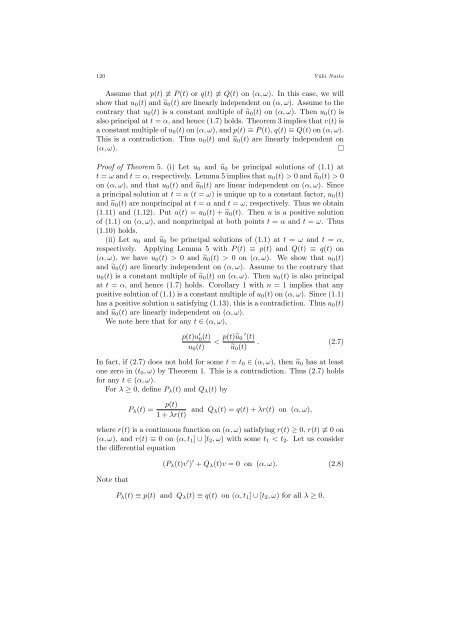REMARKS ON SINGULAR STURM COMPARISON THEOREMS
REMARKS ON SINGULAR STURM COMPARISON THEOREMS
REMARKS ON SINGULAR STURM COMPARISON THEOREMS
Create successful ePaper yourself
Turn your PDF publications into a flip-book with our unique Google optimized e-Paper software.
120 Yūki Naito<br />
Assume that p(t) ≢ P (t) or q(t) ≢ Q(t) on (α, ω). In this case, we will<br />
show that u 0 (t) and ũ 0 (t) are linearly independent on (α, ω). Assume to the<br />
contrary that u 0 (t) is a constant multiple of ũ 0 (t) on (α, ω). Then u 0 (t) is<br />
also principal at t = α, and hence (1.7) holds. Theorem 3 implies that v(t) is<br />
a constant multiple of u 0 (t) on (α, ω), and p(t) ≡ P (t), q(t) ≡ Q(t) on (α, ω).<br />
This is a contradiction. Thus u 0 (t) and ũ 0 (t) are linearly independent on<br />
(α, ω).<br />
□<br />
Proof of Theorem 5. (i) Let u 0 and ũ 0 be principal solutions of (1.1) at<br />
t = ω and t = α, respectively. Lemma 5 implies that u 0 (t) > 0 and ũ 0 (t) > 0<br />
on (α, ω), and that u 0 (t) and ũ 0 (t) are linear independent on (α, ω). Since<br />
a principal solution at t = α (t = ω) is unique up to a constant factor, u 0 (t)<br />
and ũ 0 (t) are nonprincipal at t = α and t = ω, respectively. Thus we obtain<br />
(1.11) and (1.12). Put u(t) = u 0 (t) + ũ 0 (t). Then u is a positive solution<br />
of (1.1) on (α, ω), and nonprincipal at both points t = α and t = ω. Thus<br />
(1.10) holds.<br />
(ii) Let u 0 and ũ 0 be principal solutions of (1.1) at t = ω and t = α,<br />
respectively. Applying Lemma 5 with P (t) ≡ p(t) and Q(t) ≡ q(t) on<br />
(α, ω), we have u 0 (t) > 0 and ũ 0 (t) > 0 on (α, ω). We show that u 0 (t)<br />
and ũ 0 (t) are linearly independent on (α, ω). Assume to the contrary that<br />
u 0 (t) is a constant multiple of ũ 0 (t) on (α, ω). Then u 0 (t) is also principal<br />
at t = α, and hence (1.7) holds. Corollary 1 with n = 1 implies that any<br />
positive solution of (1.1) is a constant multiple of u 0 (t) on (α, ω). Since (1.1)<br />
has a positive solution u satisfying (1.13), this is a contradiction. Thus u 0 (t)<br />
and ũ 0 (t) are linearly independent on (α, ω).<br />
We note here that for any t ∈ (α, ω),<br />
p(t)u ′ 0(t)<br />
u 0 (t)<br />
< p(t)ũ 0 ′ (t)<br />
ũ 0 (t)<br />
. (2.7)<br />
In fact, if (2.7) does not hold for some t = t 0 ∈ (α, ω), then ũ 0 has at least<br />
one zero in (t 0 , ω) by Theorem 1. This is a contradiction. Thus (2.7) holds<br />
for any t ∈ (α, ω).<br />
For λ ≥ 0, define P λ (t) and Q λ (t) by<br />
P λ (t) =<br />
p(t)<br />
1 + λr(t) and Q λ(t) = q(t) + λr(t) on (α, ω),<br />
where r(t) is a continuous function on (α, ω) satisfying r(t) ≥ 0, r(t) ≢ 0 on<br />
(α, ω), and r(t) ≡ 0 on (α, t 1 ] ∪ [t 2 , ω) with some t 1 < t 2 . Let us consider<br />
the differential equation<br />
Note that<br />
(P λ (t)v ′ ) ′ + Q λ (t)v = 0 on (α, ω). (2.8)<br />
P λ (t) ≡ p(t) and Q λ (t) ≡ q(t) on (α, t 1 ] ∪ [t 2 , ω) for all λ ≥ 0.

















